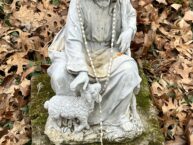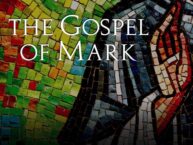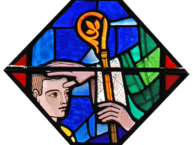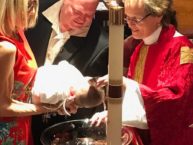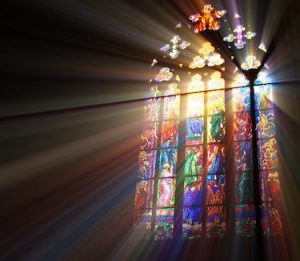 February 23, 2020: May God’s words alone be spoken, may God’s words alone be heard. Amen.
February 23, 2020: May God’s words alone be spoken, may God’s words alone be heard. Amen.
Sometimes, there is just a part of the prescribed texts for a Sunday that scream out for attention, and while it is not the focus of what I want to talk with you about today, I do want to speak to this line in the epistle of Peter. The text ended with this “First of all you must understand this, that no prophecy of scripture is a matter of one’s own interpretation, because no prophecy ever came by human will, but men and women moved by the Holy Spirit spoke from God.”
You might hear that and think, well, what the heck are we doing then? There shouldn’t be bible studies, or seminaries, or even sermons…well, okay, you might feel that way about preaching regardless of what the text says. Or worse, you might think this means we should just read the bible literally, or that what is written cannot be questioned.
So, let me just say this… it is true that that “no prophecy of scripture is a matter of one’s own interpretation because no prophecy ever came by human will, but men and women moved by the Holy Spirit spoke from God.” But that does not mean we don’t interpret scripture – we just interpret it in the same way it came about – as people moved by the Holy Spirit. For far too long, people have used our sacred texts literally, and sometimes for their own purposes – to support slavery, to justify gender bias, to marginalize and oppress LGBT people, and by some purported “evangelists,” to promote a “prosperity gospel” that preys on the poor. None of this, I assure you, comes from the Holy Spirit. It comes from our desire to make God in our image, rather than the other way around – so God hates who we hate, and the bible is a tool for our selfish desires.
What this passage is saying is that through conversation with the Holy Spirit people have been inspired to write our scriptures, and in the same way, we must read, mark, and inwardly digest the same. Our texts are living, sacred gifts, but they are not meant to be cemented in an ancient societal context or used as a weapon because the authors were writing from within that culture. Or put another way, God gave us a brain, so don’t check it at the door of the church – use it.
Okay, now that I got that off my chest, what I really want to focus on today is the gospel – the story of the transfiguration. Jesus grabs Peter, James, and John and takes them up to the top of a mountain. There they see him with two dead guys – Elijah and Moses. If that weren’t enough to rattle their cages, Jesus becomes his own flashlight – the text says that he was transfigured and his clothes became “dazzling white,” but the Greek is even better. While NRSV gives us “dazzling white” for what Jesus looked like, most other translations say “white as (the) light,” which is more literal. It speaks to the inner reality of Jesus being “the light.””[1]
So – the three boys up there seeing all this are getting quite the show! They by now are wondering if perhaps they had too much wine at dinner. Of course there’s the comic bit about Peter jabbering on and God essentially saying “shut up and listen,” and then Jesus telling them “Dudes…let’s keep this on the QT, okay, at least until later.” Something tells me they were relieved to hear that – because they were probably thinking if they went down the mountain and said “Hey – we just saw Jesus lit up like a fireball, and guess who’s coming to dinner – Elijah and Moses!” their buddies might just think they were few sides short of a full dreidel…or whatever the 1st century equivalent to crazy would be.
So that’s our story…but…wait for it – interpretation – what does it mean for us today? One of the reasons we hear this narrative on the last Sunday of Epiphany, even though the Feast of the Transfiguration is August 6th, is because Epiphany – meaning manifestation or appearance – is when we begin to understand what the incarnation was all about through seeing Jesus – really seeing him. And I would argue that Epiphany, while ending today liturgically, is something that we are in every single day as followers of Jesus – or at least we should be.
Every day we should be looking for the Jesus standing in front of us, and working through us. He may not be all lit up, and we won’t always need to go to a mountain top to see him, but in those thin places – as the Celts like to call spiritual places like mountaintops – in those thin places, our hearts and minds tend to still and make us ready to see God’s manifestation. Where are those thin places for you? Here, in this place, at this table, is one – or so I hope, but it isn’t the only place. Look for them, and look for Jesus – because we do need to be looking for God’s presence – perhaps now more than ever.
See, that is the root of what the bishop was talking about – what I will talk about a lot this year – because it is a crisis in the church right now. We have a stewardship crisis (and of course that isn’t just about money), and stewardship crises are spiritual crises – it means we cannot see the God at work in the world, and in our lives, and then respond to it. And that, my friends, troubles me deeply. It cuts me to the core and makes me weep.
And Jesus was seeing that difficulty at work in his own disciples too, and it pained him, I think. And so he picked these three to go up on the mountain to see this because they likely were the ones who needed it the most. Yes, Peter had just, in the passages before this, proclaimed Jesus as the messiah, but in typical Peter fashion, he didn’t really understand what that meant, and tried to tell Jesus what being the messiah was about. And of course, on the mountaintop we hear him trying to box this experience in was well. In fairness, Peter was, as we all tend to do, responding to his encounter with the divine through the framework of his faith.
We all seem to do that with things we value. We want to capture the experience – in photos, video, cherished items – so that we always have them right there, right in our grasp. But Jesus is changing how we move in the world, and he is not about to be contained in some neat box. Jesus is always on the move!
It reminds me a bit of a scene in the first Harry Potter book, or movie. Young Harry is riding on the Hogwarts Express train on the way to school for his first time. He is new to the wizarding world, and so when he and new friend Ron Weasley are scoffing down some treats from the trolly, Harry is surprised to find magical chocolate frogs – and his leaps out of the box, and then out of the train. “Rotten luck,” says Ron. “They only have one good jump in them.” But in these chocolate frog boxes are cards, like baseball cards, only these have famous witches or wizards on them. Harry is delighted that he has Albus Dumbledore, the famous headmaster of Hogwarts that he has heard so much about. Then he looks down again, and Professor Dumbledore is gone! He isn’t in the card anymore. Ron explains to Harry “Well, you can’t expect him to hang around all day, can you?’
You can’t expect Jesus to hang around all day on the mountain either, or only in those thin places, or box him into these walls on a Sunday. Epiphany moments are all around us, and if we are to be the people of the Jesus Movement (and notice the word move in movement), if we want to be part of the Jesus Movement we are called to be, we must look for him, see him, respond to him – in the world, and in each of us. For if we do not, this spiritual crisis we face will only grow. And part of the way this church did this, the way we chose to look for him, is in our Epiphany Project.
Today we are gathered as a whole family – not divided into two services, but joined together, that after this service we might share with one another what manifestations of Jesus happened to us as we participated in the Epiphany Project. As most of you know, those who pledged to the church – no matter how much – received an equal share of our outreach budget in the form of a $200 blank check. In the memo line was this: “In the name of Jesus Christ via…” and then the name of the person it was given to. You were then asked to pray, discern, and then give this money to those who are serving others in the world – where we found Jesus at work around us. As you gave these funds out, you put the name of the organization on these stars of Bethlehem, and they were then placed on these boards.
Why did we do this? For the same reason it was called the Epiphany Project. In our ministry outside these doors, we will encounter Christ, and in that epiphany, we are transfigured – the Christ inside us becomes manifest in ways often unexpected. And that in turn becomes an epiphany moment for someone else. Just look at all the light shining in the darkness – his light, through you! Such is the life of a follower of Jesus.
See, I think that we are a lot like the stained glass we find in our churches. These were originally meant for the illiterate masses of the early church – they told the story of our faith in pictures. But we are also like them. Our lives, our very world, can seem cracked, almost a bit broken into pieces, and yet, when we let the sun – Jesus, the son of God – shine through us, we are transfigured into the beautiful children of God that we are – we don’t have to do anything but let his light shine in our hearts for us to be changed. And in those moments, when we are radiating with his light, the light of love, and grace, we transform others.
Today we end the liturgical season of Epiphany, when we have been seeing the Christ manifested in the world – learning who Jesus is. But this week we enter into Lent, a time for us to learn who we are, as followers of Christ. And it is here, in this thin place, at this table, where you can come down off the mountain and walk with him – where you can be nourished and fed with his grace – where you can journey with others as you seek to find your own self, your place in the cosmos, your call as God’s beloved.
And as we discern all of this together, remember these Epiphany Project moments – those you have experienced personally, and those you will hear shared by others today. Remember your experience of Jesus in the world, and in your lives. And perhaps most of all, remember that you are God’s stained glass window – shining the light of Christ through your own brokenness, and transfiguring the world.
I am going to close with this quote that you have heard me use many a time. It is from the former Archbishop of South Africa, the Most Rev. Desmond Tutu, a prophet and part of our own Anglican Communion. I repeat this often because in his words, he offers us a mantra for the Christian life arising from the experience of transfiguration – and it is so very needed today. And so I offer it once more in the hope that you carry it in your hearts as we enter into Lent:
He said, “All over this magnificent world God calls us to extend [the] kingdom of shalom-peace and wholeness — of justice, of goodness, of compassion, of caring, of sharing, of laughter, of joy, of reconciliation. God is transfiguring the world right this very moment through us because God believes in us and because God loves us. What can separate us from the love of God? Nothing. Absolutely nothing. And as we share God’s love with our brothers and sisters, God’s other children, there is no tyrant who can resist us, no opposition that cannot be ended, no hunger that cannot be fed, no wound that cannot be healed, no hatred that cannot be turned into love, no dream that cannot be fulfilled.”
“God is transfiguring the world right this very moment through us because God believes in us and because God loves us.”
That, my friends, is an Epiphany for us all.
Amen.
[1] Bob Eldan, preachingtips.com
For the audio from the 10:30am service, click below, or subscribe to our iTunes Sermon Podcast by clicking here:
The Rev. Diana L. Wilcox
Christ Church in Bloomfield & Glen Ridge
February 23, 2020
The Last Sunday After The Epiphany
1st Reading – Exodus 24:12-18
Psalm 2
2nd Reading – 2 Peter 1:16-21
Gospel – Matthew 17:1-9

